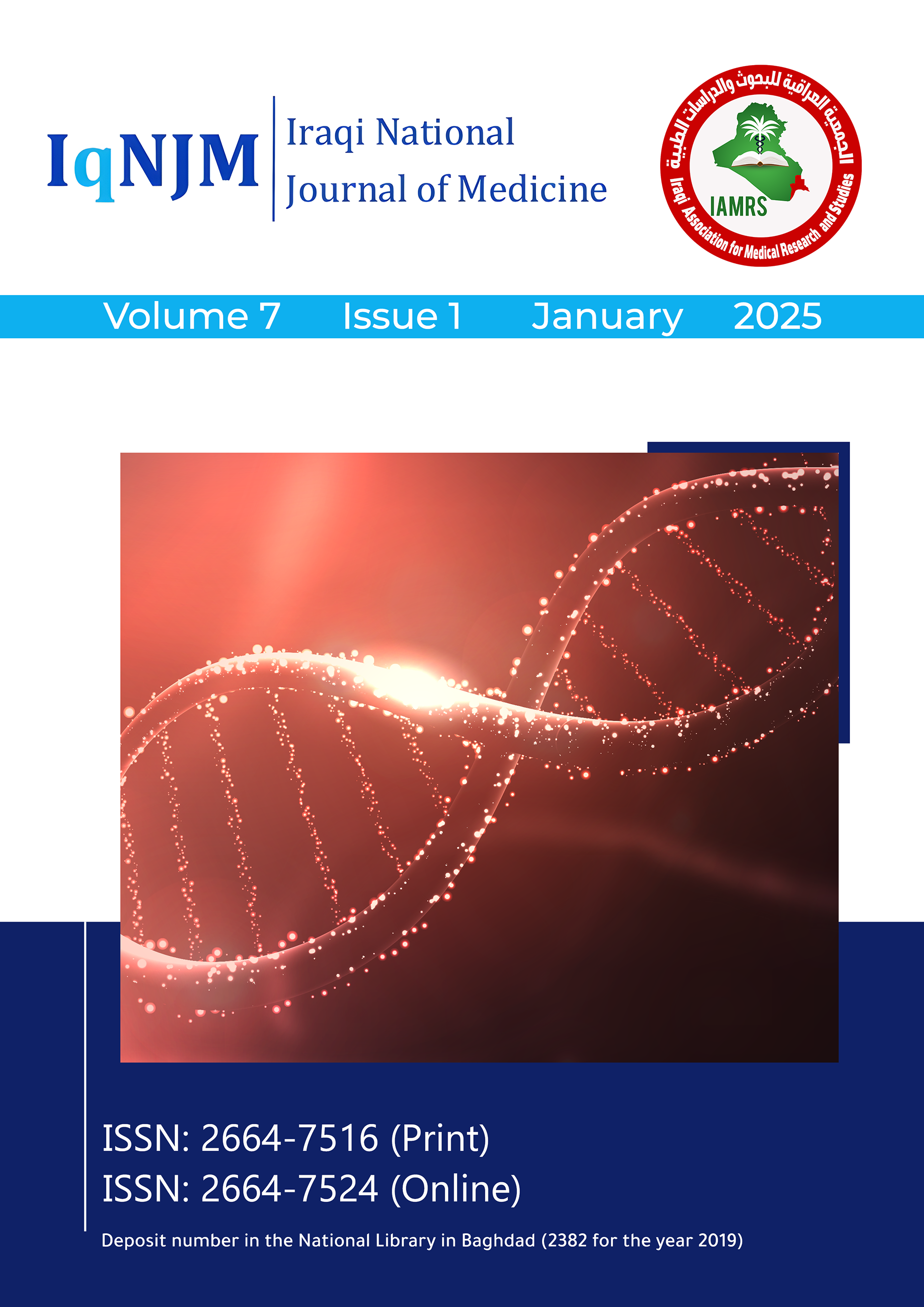Peritoneal dialysis in Iraq: Past and the modern era
Main Article Content
Keywords
peritoneal dialysi, AKI, CAPD
Abstract
Background: The peritoneal cavity, a region of the abdomen, receives dialysate, a cleansing solution, via a catheter tube. The dialysate removes waste from blood vessels in the peritoneum; subsequently, the fluid is removed from the body and disposed of. Benefits of chronic PD include reduced costs, home-based therapy, single access, a decreased need for highly skilled workers and large infrastructure. Aim: This study aimed to assess the prevalence and outcomes of acute and chronic PD in the Iraqi population Methods: We have gathered data regarding every patient who received acute and chronic peritoneal dialysis in Iraq in period between 2016-2024 to know the prevalence and mortality rate.450 patients with end stage renal disease undergo chronic peritoneal dialysis in AL-Najaf center. 950,459,74,23 patients have acute peritoneal dialysis in children welfare teaching hospital. Mosul,AL-Nasyrea and AL-Basra centers respectively. Results: Among the subjects, 450 patients underwent chronic dialysis at the Al-Najaf center, with a mortality rate of 41%. Sepsis and cardiac disease were the most common causes of death. Four percent underwent kidney transplant, and 18% were transferred to hemodialysis. Regarding acute pediatric PD, a high rate of complete recovery was observed at the Children Welfare Teaching Hospital and Mosul, Al-Nasyrea, and Al-Basra centers, with rates of 72%, 83%, 70%, and 48%, respectively. The death rates in these centers were 25.7%, 16.7%, 29.7%, and 26%, respectively. Conclusions: The findings demonstrate that infection and cardiovascular diseases are the most common causes of death in adult CAPD patients; a high recovery rate can be achieved from acute peritoneal dialysis in children; and limited access to CAPD solutions complicates practice.
References
2. Pedersen KR, Hjortdal VE, Christensen S, Pedersen J, Hjortholm K, Larsen SH, Povlsen JV. Clinical outcome in children with acute renal failure treated with peritoneal dialysis after surgery for congenital heart disease. Kidney Int Suppl. 2008;108:S81-S86.
3. Abraham G, Varughese S, Mathew M, Vijayan M. A review of acute and chronic peritoneal dialysis in developing countries. Clin Kidney J. 2015;8:310-317.
4. Morelli S, Ricci Z, Di Chiara L, Stazi GV, Polito A, Vitale V, Giorni C, Iacoella C, Picardo S. Renal replacement therapy in neonates with congenital heart disease. Contrib Nephrol. 2007;156:428-433.
5. Karkar A, Wilki M. Peritoneal dialysis in the modern era. Peritoneal Dialysis International. 2023 Jul;43(4):301-314.
6. Kumar V, Ramachandran R, Rathi M, Kohli HS, Sakhuja V, Jha V. Peritoneal dialysis: the great savior during disasters. Perit Dial Int. 2013;33:327-329.
7. Anochie IC, Eke FU. Acute renal failure in Nigerian children: Port Harcourt experience. Pediatr Nephrol. 2005;20:1610-1614.
8. Mishra OP, Gupta AK, Pooniya V, Prasad R, Tiwary NK, Schaefer F. Peritoneal dialysis in children with acute kidney injury: a developing country experience. Perit Dial Int. 2005;32:431-436.
9. Hoste EA, Clermont G, Kersten A et al. RIFLE criteria for acute kidney injury are associated with hospital mortality in critically ill patients: a cohort analysis. Crit Care. 2006;10: R73.
10. Shah BN, Greaves K. The cardiorenal syndrome: a review. Int J Nephrol. 2011:920195.
11. Burdmann EA, Chakravarthi R. Peritoneal dialysis in acute kidney injury: lessons learned and applied. Semin Dial. 2011;24:149-156.
12. Nada D. Peritoneal dialysis in acute kidney injury. Bantao J. 2010;8:54-58.
13. Bonilla FM. Peritoneal dialysis in the pediatric intensive care unit setting. Perit Dial Int. 2009;29(Suppl 2):S183-S185.
14. George J, Varma S, Kumar S et al. Comparing continuous venovenous hemodiafiltration and peritoneal dialysis in critically ill patients with acute kidney injury: a pilot study. Perit Dial Int. 2011;31:422-429.
15. Chaudhary K, Sangha H, Khanna R. Peritoneal dialysis first: rationale. Clin J Am Soc Nephrol.2011;6:447-456.
16. Wang AY, Lai KN. The importance of residual renal function in dialysis patients. Kidney Int. 2006;69:1726-1732.
17. Schaefer F, Warady BA. Peritoneal dialysis in children with end-stage renal disease. Nat Rev Nephrol. 2011;7:659-668.
18. Noori E, Hadi R, Sharba Y, Sharba ZF. Spectrum of complications of patients with chronic kidney disease on maintenance continuous ambulatory peritoneal dialysis: an experience of tertiary nephrology center in Najaf City-Iraq. Open Access Maced J Med Sci. 2021;Oct 13;9(B):1529-1534.
19. Dilek Barutçu Ataş, Ebru Aşıcıoğlu, Murat Tuğcu, Izzet Hakkı Arıkan, Arzu Velioğlu. Long-term predictors of mortality in peritoneal dialysis patients. doi:10.5152/turkjnephrol.2021.4712.
20. Najafi I, Alatab S, Atabak S, et al. Seventeen years’ experience of peritoneal dialysis in Iran: first official report of the Iranian Peritoneal Dialysis Registry. Peritoneal Dialysis International. 2014;(34):636-642.
21. Nariman FA, Azat, CABP, FICMS-ped, nephrology. Indications and complications of peritoneal dialysis in children with acute renal failure: a single center experience. J Fac Med Baghdad. 2016; 58(2).
22. Alao MA, Ibrahim OR, Asinobi AO, Akinsola A. Long-term survival of children following acute peritoneal dialysis in a resource-limited setting. Kidney Res Clin Pract. 2020;39(4):469-478.
23. Ali J Al-Saedi. Outcome and complications of acute intermittent peritoneal dialysis in Al-Kindi teaching hospital. Iraqi J Med Sci. 2013;11(3).
24. Abdullah SZ. Peritoneal dialysis in children with acute renal failure in Ibn Al-Balady hospital. The Iraqi Postgrad Medical Journal Peritoneal Dialysis. 2015;14(1).


